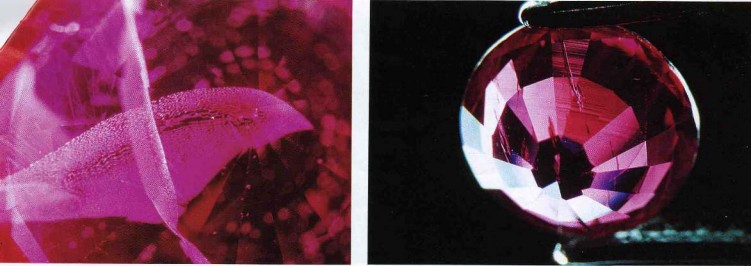
The Resurrection of Synthetic Coloured Stones

by Dr. M. S. Krzemnicki first published in Facette 25 (February 2019)
Occasionally, we encounter synthetic stones at SSEF that are submitted to us by our clients. Usually they are quite surprised by our result, as the issue of synthetic stones – at least in the coloured stone market – has very much vanished in peoples’ minds, and is often not anymore considered a real threat when purchasing stones from an unknown supplier or at a local gem market. Furthermore, some rather classic features of synthetic stones are not anymore known to young gemmologists, further adding danger that such stones pass into the market as natural after a first gemmological test (see also SSEF Facette No. 22, 2016, page 14).
In recent months, we have encountered a number of synthetic stones worth describing in a short note, namely synthetic rubies and red spinels, but also a few synthetic corundum samples of blue and padparadschalike colour.
Synthetic corundum produced by the flame fusion method (Verneuil) are somehow regular guests at SSEF. Nevertheless, it was interesting for us to be recently able to test a brooch of historic design (Figure 1) containing 27 small synthetic rubies. All were characterized by strong curved banding and large air bubbles, thus probably of a quite historic synthetic production.

In addition to this, our client was quite shocked when the 20 ct sapphire set in a ring with real diamonds (of low quality though) turned out to be a classic Verneuil-synthetic product (Figure 2). Even worse was the case of a colourless synthetic corundum which was treated by Ti-diffusion to visually produce a blue colour (Figure 2), but resulting under the microscope in a highly characteristic facet-related colour distribution.

Apart from blue and red, flame-fusion synthetic corundum can be produced in virtually all colours, including emerald-green by doping aluminium oxide with traces of nickel. Using the same trace element, it is also possible to produce yellow to orange and (in the presence of some chromium) pinkish orange corundum, visually beautifully blending with the sought-after natural variety padparadscha (Figure 3). Simple to identify with lab equipment based on their specific trace element composition (Ni traces, but no Ga), these stones may be more challenging when on a buying trip in remote places. Interestingly, however, the displayed two client stones both reveal a ‘Punsiri-type’ infrared spectrum with a broad (presumably OH- related) absorption band centered at about 3000 cm-1 wavenumbers (Figure 4). This feature is very similar to those described by Fukatsu et al. (2003) in Mg-doped synthetic corundum, or in so-called ‘Punsiri heat-treated’ blue sapphires and certain untreated yellow basaltic sapphires (Sangsawong et al. 2016; in Gems & Gemology), and even in blue sapphires treated by a pressure-assisted heat treatment (GIT Gemstone Update, 2016).

In contrast to the rather straightforward cases described above, the identification of flux-grown synthetic products is far more challenging and intriguing even at lab level. In the past few months, we were astonished to see again quite an impressive number of such stones in the SSEF, partly accompanied by documents describing them as natural stones. Whether submitted in larger parcels or as single loose stones, the tested flux-grown synthetic rubies (Figure 5) and synthetic red spinels (Figure 6) all could be identified based on characteristic inclusions and trace elements, with the GemTOF notably revealing ‘exotic’ elements such as platinum, rhodium, zirconium, tantalium, lanthanum, and bismuth, to name a few.


Still, inclusion features in some of these flux-grown synthetic stones may have some resemblance with those in natural rubies and spinels, which makes a very careful microscopic examination and testing protocol mandatory. In this respect, we present here a selection of microphotos (Figure 7a-f) with inclusion features encountered in fluxgrown synthetic stones which were analyzed recently at SSEF. For a more detailed description of flux grown synthetic rubies and spinels, we refer the interested reader to SSEF Facette No. 22 (2016; page 14. Short note about Ramaura synthetic ruby), and the SSEF trade alert (November 2008) about flux-grown synthetic spinel, all documents accessible on our SSEF website.



